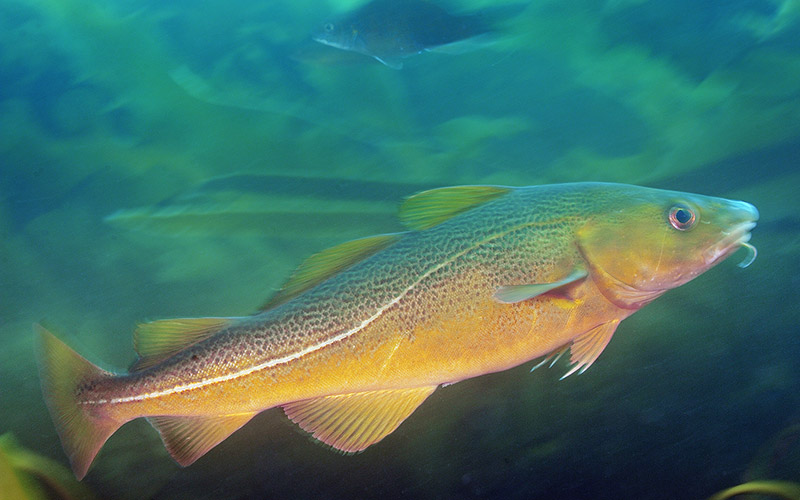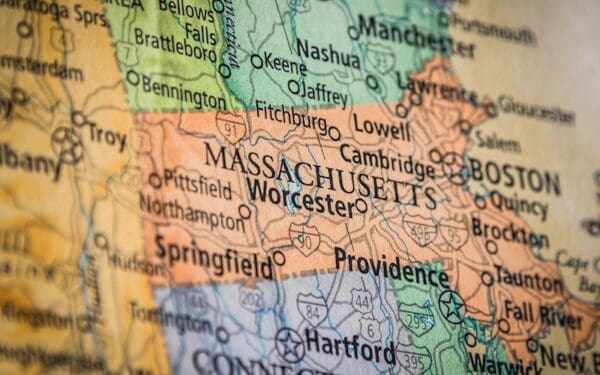
A red cod swims amid seaweed. Photo: Brian Skerry
I started studying Atlantic cod, New England’s founding fish, almost 30 years ago, grappling with a thorny set of questions about their movements in coastal Newfoundland. Where did they live? How were they moving around Newfoundland’s waters? And what were their home territories? How could we ensure a sustainable future for the cod populations and the coastal communities that rely on them?
What I studied as a scientist back then echoes in CLF’s work in New England today. The picture of how many distinct cod populations live in New England waters has changed dramatically – research finalized in 2022 has shown there are more distinct populations than previously thought. (A “population” is a group of cod that doesn’t interbreed with other groups.) Cod numbers across New England stand at historic lows, well below the target levels that would support their long-term sustainability, and this misunderstanding helped get us here. And if we don’t take action, the outlook is bleak for this iconic species and the communities that count on cod fisheries for their livelihoods.
Despite these discouraging facts, our knowledge of cod and the science of tracking them and telling different populations apart have improved. In CLF’s long history of advocating for sustainable cod fishing, we’ve always grounded our advocacy in the best science available. We’re working to ensure this new science will help cod populations rebound.
New England Has More Distinct Atlantic Cod Populations Than Thought
Atlantic cod are fascinating creatures with complex behaviors mostly hidden from us beneath the water’s surface. Scientists recently confirmed one hidden fact: While the overall number of cod in New England has fallen, they are divided into more distinct populations than we thought. This is crucial information because scientists need to know the number of cod populations and their home territories to estimate the number of fish and set sustainable limits on how many cod fishermen can catch.
Our incomplete science has led to flawed fishing management policies. In part due to an inaccurate understanding of cod populations and their territories, well-intentioned fishery managers have historically set limits on fishing that have resulted in overfishing of cod. Think of it as trying to measure and manage the populations of New Hampshire and Massachusetts without knowing where the border is or that people commute back and forth every day.
In our local New England waters, we’ve always thought there were two populations of cod: one straddling Georges Bank (an underwater plateau east of Cape Cod and south of Novia Scotia) and adjacent waters off southern New England and the other in the Gulf of Maine. Scientists assumed that cod from the two populations stayed in their home areas and didn’t mix.
After nearly two decades of research, we now know that in reality, five populations live in New England waters: one on Georges Bank, another off southern New England, one in the eastern Gulf of Maine, and two that overlap in the western Gulf of Maine. And the new boundaries of their home areas look a lot different than we thought. Complicating things even further, the two overlapping populations in the western Gulf of Maine can’t be separated out and have to be managed together, making it harder to set management measures that benefit both populations.
This new scientific picture of five populations aligns better with what fishermen see out on the water. Fishermen develop a keen understanding of how the fish they target move over seasons. Commercial and recreational cod fishermen have long pointed out that the old “two-population” approach and its boundaries didn’t fit with what they saw.
Protecting Atlantic Cod from Climate Change
CLF is working hard to make sure that plans based on the new scientific understanding about populations will end overfishing and put the populations on a path toward healthy levels. Rebuilding our cod populations isn’t just important for ensuring sustainable fishing. It’s also key to helping cod deal with climate change. The Gulf of Maine’s waters are warming faster than 97% of the world ocean, and cod are feeling it.
Like you and me, cod have a ‘Goldilocks’ temperature range that they prefer to inhabit – not too hot, not too cold. Temperatures outside that range can compromise their metabolism, growth rate, disease resistance, and more. Also, as with people, not all cod are the same. The five New England cod populations could hide sub-groups that are more resilient to warmer waters based on their genetics.
Rebuilding all populations to healthy levels and conserving genetic resilience are crucial to combating the additional stress of a warming ocean.
Ensuring a Sustainable Future for Cod
Cod in New England sit at a crossroads. Like we’ve done for decades, CLF will hold fishery managers accountable to the law. We will advocate for plans to rebuild each Atlantic cod population and approaches to managing cod that preserve both cod populations and the long-term sustainability of the fisheries. The new scientific understanding shows the state of the cod populations remains grim. Still, that same science gives us our best, renewed opportunity to successfully rebuild cod to healthy, sustainable levels.
Sign up for CLF emails so you don’t miss your chance to let the federal government know you want to see a sustainable future for Atlantic cod.



